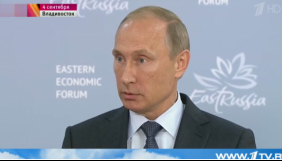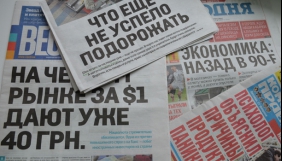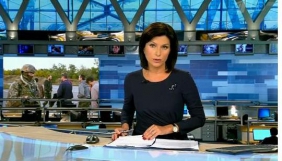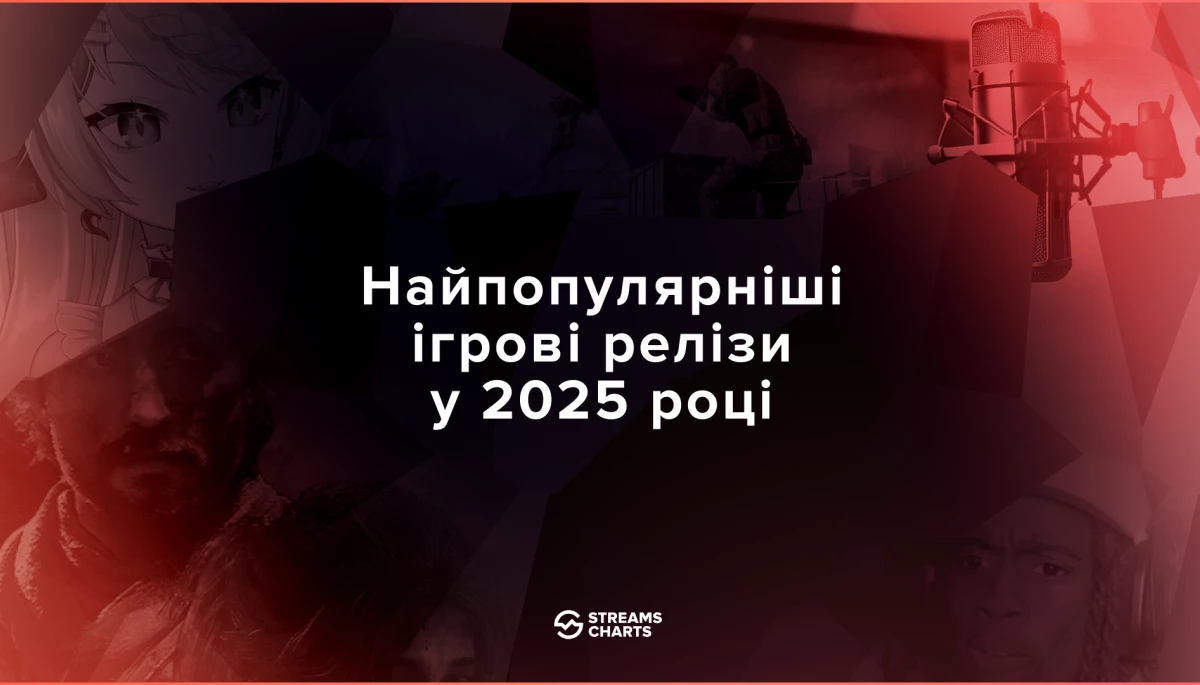
Виділіть її та натисніть Ctrl + Enter —
ми виправимo
Twilight of Russian Journalism. Propaganda-2014
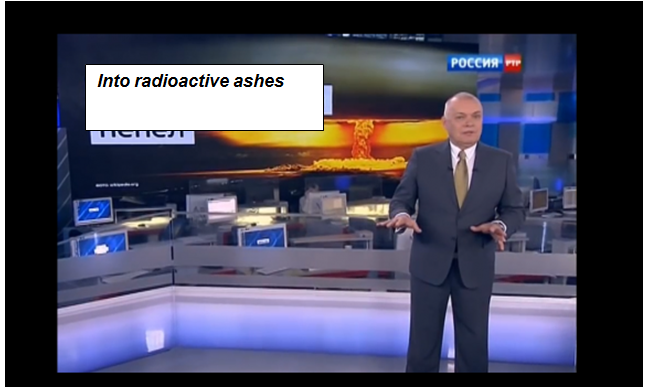

During 2014 Telekritika, with USAID support provided via Internews Network, has been monitoring the Russian media. This piece is a consolidated report of monitoring results. All monitoring reports (in Ukrainian) can be found in the “Russian Media” column on MediaSapiens web-site. English versions are found in the column “In English”.
When in 2008 Edward Lucas published his book “The New Cold War: How the Kremlin Menaces Both Russia and the West”, he was heavily criticized. Western politicians and journalists proved to be short-sighted having rejected the Lucas’s predictions and his term ‘new cold war’. The West has reconsidered its attitude to Russia six years after the book was published under the pressure of new dramatic and undisputed circumstances: the Crimea annexation and the war with Ukraine launched by Russia. And as the Russian propaganda penetrates the Western media landscape, the heads of major countries of the world will have to bring up the menace of Russian propaganda.
The US President Barack Obama was among the first to warn about it. The President of Lithuania Dalia Grybauskaite suggested fining both broadcasters and re-broadcasting companies for the calls to change the constitutional order and to encroach upon sovereignty of the country, as well as to revoke their license. She claims this is necessary since ‘Lithuania lives in information war’. At the end of 2014, the UK Prime Minister David Cameron also spoke about the Russian propaganda. Speaking to the Parliament, he said that the Russian propaganda was “creating a distorted picture” of events in Ukraine. And the former director of BBC World Service Peter Horrocks insists that ‘BBC has to play more important role to compete the Kremlin propaganda’.
What made the Kremlin launch the ‘new cold war’ against the West? This is a topic for a separate research. I would like only to mention: an opportunity to get beyond the Russia’s control has become so real for Ukraine (much more real than during the Orange Revolution 2004) that Putin could not put up with it since he considered this scenario as a menace both to him personally and to his regime. Apparently, the 2004 lessons were learnt: measures must be more decisive and aggressive this time. And Putin made a move. But he needed validation of his actions in Crimea and Eastern Ukraine by his citizens as well as by the whole world. And this could be achieved by creating a new reality with mass media.
Thus, the Russian media abandoned the ethics of journalism and professional standards and moved to propaganda switching their attention from internal to external affairs. They made a firm image of Ukraine as an enemy in 2014, and this is proven by a number of surveys of Russian population held by Levada-Center.
State-owned TV-channels Russia 1 and Russia 24 have become the major propagandists; later Zvezda TV-Channel of Russian Ministry of Defense joined them. Moreover, propaganda became a part of editorial line of private media as well, firstly, of the ones financed – fully or partly – by Gazprom or pro-Putin oligarchs, in particular, NTV channel, Komsomolskaya Pravda and Izvestia newspapers etc. The western English-speaking audience is affected by Russia Today and numerous experts - Russia’s lobbyists appearing in western media. The fake and staged news are often supplied by LifeNews TV-channel (News Media holding owned by Aram Gabrelyanov).
Intensity of Russian Propaganda
The intensity of news about Ukraine broadcast in Russian media has been fluctuating during the year. It was on top in the periods of:
- Maidan,
- Crimea annexation,
- start of military actions in the East of Ukraine.
Almost the whole newscast time was dedicated to Ukraine during these periods. Since September 2014, the decline in intensity of reports on Ukrainian events and change in rhetoric were noticed.
Below are presented the figures of time dedicated to Ukrainian events by Russian news of Channel One and Russia 1.

Komsomolskaya Pravda was an active propaganda mouthpiece of Kremlin in 2014. This is a daily newspaper in Russia. In certain months, it has dedicated almost a half of its issues to Ukraine. For example, it had 19 covers on Ukrainian matter in March and 13 - in June.

These figures show that the attention to Ukraine has been decreasing in the last months of 2014, and Russian media gradually return to internal problems of Russia.
Russian media were changing their rhetoric about the events in Ukraine during the year. Main messages imposed by Russian propaganda:
1. Ukraine is not a state, Ukraine is a failed state.
The topic of Ukraine’s disintegration and impossibility of Ukraine’s existence within the set boundaries is not new for Russian media. It was first mentioned during the Orange Revolution. Given the recent developments, it was refreshed in the end of 2013. For example, the Russian review ‘Expert’ (No. 48 of 2-8 December 2013) has a cover: “Painful Doom. Ukraine is Dreaming of Europe but Cannot Be Without Russia”, and the article of journalist Olga Vlasova “Final Competition” alleges that Ukraine is going to be split into parts the long run. ‘One shall be aware that the ‘final competition’ between Russia and Europe for the whole Ukraine (Ukraine as a whole) is impossible. The association agreement conflict is a solid proof. The aftermath of ‘final choice’ turns to be incompatible with the very existence of Ukraine in its current form,’ summarizes Vlasova.
The thesis of Ukraine’s disintegration in different versions is constantly present in Russian media.
2. Demonization of the Maidan protesters, and later, after the launch of military conflict in the East, of Ukrainians and anything Ukrainian in general.
This was achieved by means of hate speech and war rhetoric: “Banderites”, “fascists”, “neo-Nazi”, “thugs”.
Russian media constantly keep attention to actions of Ukrainian right and radicals (Right Sector, Svoboda, Liashko).

3. Delegitimization of the Ukrainian authorities and legitimization of the terrorist groups
After Yanukovych had escaped to Russia, the Russian media started to delegitimize the new Ukrainian authorities. They have been predominantly called ‘junta’ and later ‘chasteners’. Such terms have been used until autumn. Starting from September, ‘junta’ word has been vanishing from Russian TV-channels’ broadcasting – this is noted by our monitoring reports.
The events in the East of Ukraine and terrorist groups were legitimized by means of Novorossiya image. Later, after the pseudo-referendum, ‘Donetsk People’s Republic’ and ‘Luhansk People’s Republic’ have been used. There were also other terms: ‘Crimea self-defense’, ‘militants’, ‘people’s governor’ or ‘president of Donetsk People’s Republic’, ‘Donetsk army’, and ‘DPR police’.
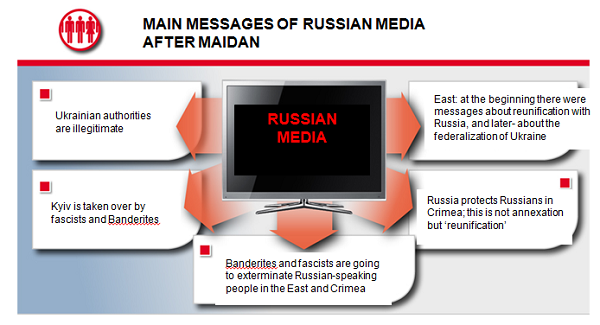
The introduction of different characters, like Strelkov-Girkin, into information realm (with further disposal when the task is performed) was exemplary. During the first stage of the events in the East, before the pseudo-referendum, he was in the focus of Russian media, but since September he has disappeared from the broadcasts and newspaper columns.
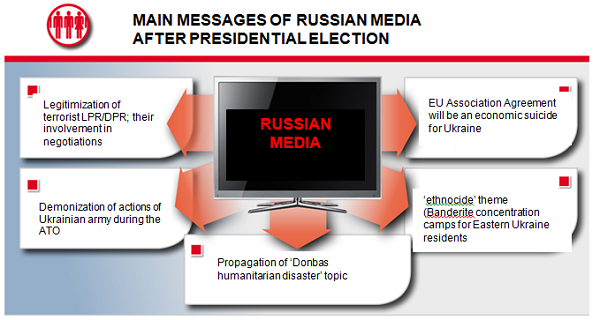
4. Discrediting of Ukraine presidential and parliamentary elections.
Russian propaganda was constantly putting an emphasis on the impossibility to hold presidential election (and the parliamentary one later) in the East of Ukraine. The thesis that presidential election is illegitimate was especially popular.
After Poroshenko had been elected, Komsomolskaya Pravda had a headline ‘Inauguration of Future Dictatorship’.
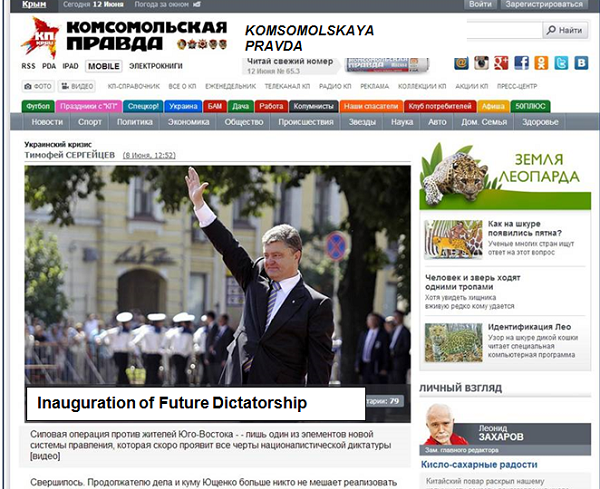
On the eve of the parliamentary election (25.10.14), the newspaper had the title ‘Council of Punitive Expedition’. Other Russian media presenting Ukraine as a ‘fascist’ state with flourishing ‘right radicalism’ kept following this trend during the Verkhovna Rada election. ‘In three weeks Ukraine is choosing between the ultra-Nazism and the mere Nazism,’ said Channel One.
Channel One, News, 05.10.2014
““Host: Ekaterina Kibalchich.
… Recent polls show that neither Svoboda nor Right Sector get to Verknovna Rada, the electorate jumps and shouts out their slogans, but does not need the parties. This paradox is easily explained. Their ideas are very attractive, but the parties are not. All Ukrainian politicians have become national patriots without any exception. And almost every party invited ‘a hero of revolution’ on its list as a sign of respect. In three weeks Ukraine is choosing between the ultra-Nazism and the mere Nazism. The majority will be cautious to elect the ‘mere’ one with ‘a human face’ as the saying goes.”
At the same time the so called elections in “DPR/LPR” are covered in positive or neutral way.
Another trend of parliamentary election campaign in Ukraine as presented by Russian media was the PR of Opposition Block and overwhelming criticism of Dnipropetrovsk governor Kolomoiskiy. Russian propaganda actively spoke how the Opposition Block candidates were oppressed, were not allowed on the air of TV-channels (whereas one of them, Sergiy Liovochkin, is a co-owner of Inter TV-channel). Russian media represented this political force as almost the only one to support peace in Ukraine. While Block of Petro Poroshenko (BPP), People’s Front and Batkivschyna and others were represented as parties of war.
And Russian media have found a new enemy - Igor Kolomoiskyi, in addition to D. Yarosh and Right Sector. For example, Zvezda TV-channel told that the Ukrainian oligarch was suspected of preparation of coup d’état in Russia.
Zvezda, 01.10.2014
“Kolomoiskyi and Yarosh suspected of preparation of coup d’état in Russia.
Mikhail Degtiarev, State Duma Deputy, offered the RF Investigative Committee to check the involvement of “Privatbank” owner Kolomoiskyi and Right Sector leader Yarosh in creation of warcamps and recruitment of Russian youth in the territory of Ukraine for coup d’état in Russia.”
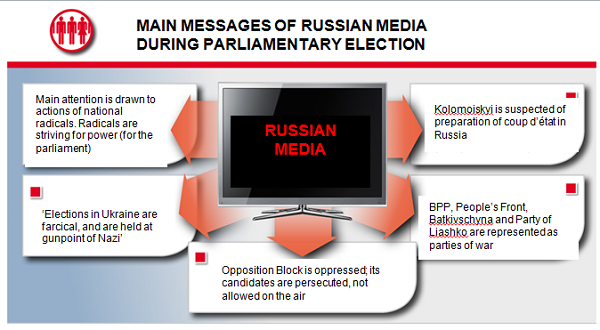
By the end of the year Russian media had to turn to internal problems: the drastic decline in Russian economy could be hardly ignored. But Russian propaganda managed to find the lightning rod in this matter: USA and EU. However things are not all that bad in Russia, its economy is strong enough, whereas in Ukraine everything is much worse: people are starving and freezing without Russian gas, as the news of Russian TV-channels told in autumn and winter.
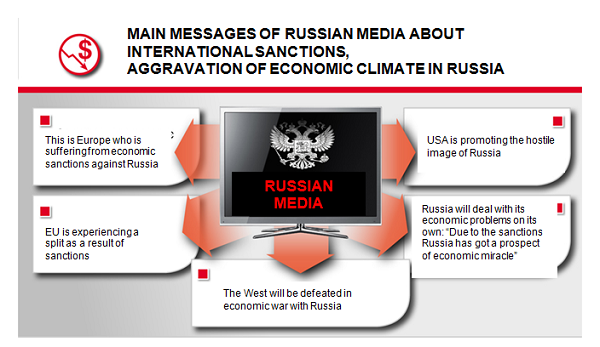
2014 is a Year of Fake News
Russian propaganda not only manipulated the hard facts but also interpreted Ukrainian events as it liked. Russian media actively created new reality producing a multitude of fake news. A crucified boy and concentration camps for refugees from the East of Ukraine stuck in my memory. In the article “A Year of Fakes: the Lies of Russian Propaganda” our author Taras Nazaruk collected the most absurd Russian fakes 2014 on the web-site of MediaSapiens.
P.S. As one may see, the frequency of references to Ukraine in Russian media has declined at the end of 2014. But this does not mean that Ukrainian events are covered in honest and unbiased manner. Russia keeps expanding its information presence in the world, including European countries, doing its best to talk the western public opinion over. And sometimes it succeeds. What Ukraine can contrapose to that is a question still to be answered.
Diana Dutsyk, Honored Journalist of Ukraine with 20-year professional background. She was editor-in-chief of a range of Ukrainian periodicals, in particular, magazine and web-site of Glavred, PiK web-site, ‘Bez Tsenzury’ (No Censorship) newspaper. 6 years as a parliamentary correspondent for ‘Ukraina Moloda’ (Young Ukraine). Professor of Mohyla School of Journalism (National University of “Kyiv-Mohyla Academy”. Author of “Political Journalism” monograph.




